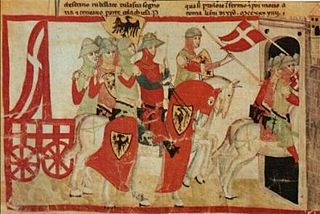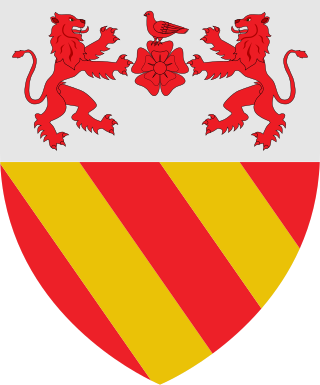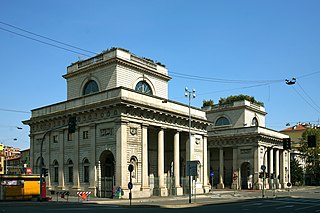Related Research Articles

The Duchy of Milan was a state in Northern Italy, created in 1395 by Gian Galeazzo Visconti, then the lord of Milan, and a member of the important Visconti family, which had been ruling the city since 1277.

The Battle of Cortenuova was fought on 27 November 1237 in the course of the Guelphs and Ghibellines Wars: in it, Holy Roman Emperor Frederick II defeated the Second Lombard League.

The Betrothed is an Italian historical novel by Alessandro Manzoni, first published in 1827, in three volumes, and significantly revised and rewritten until the definitive version published between 1840 and 1842. It has been called the most famous and widely read novel in the Italian language.

The battle of Legnano was a battle between the imperial army of Frederick Barbarossa and the troops of the Lombard League on 29 May 1176, near the town of Legnano, in present-day Lombardy, Italy. Although the presence of the enemy nearby was already known to both sides, they suddenly met without having time to plan any strategy.

The War of the League of Cambrai, sometimes known as the War of the Holy League and several other names, was fought from February 1508 to December 1516 as part of the Italian Wars of 1494–1559. The main participants of the war, who fought for its entire duration, were France, the Papal States, and the Republic of Venice; they were joined at various times by nearly every significant power in Western Europe, including Spain, the Holy Roman Empire, England, the Duchy of Milan, the Republic of Florence, the Duchy of Ferrara, and the Swiss.

Bartolomeo d'Alviano was an Italian condottiero and captain who distinguished himself in the defence of the Venetian Republic against the Holy Roman Emperor Maximilian.

The Battle of Bicocca or La Bicocca was fought on 27 April 1522, during the Italian War of 1521–26. A combined French and Venetian force under Odet de Foix, Vicomte de Lautrec, was decisively defeated by an Imperial–Spanish and Papal army under the overall command of Prospero Colonna. Lautrec then withdrew from Lombardy, leaving the Duchy of Milan in Imperial hands.

The Wars in Lombardy were a series of conflicts between the Republic of Venice and the Duchy of Milan and their respective allies, fought in four campaigns in a struggle for hegemony in Northern Italy that ravaged the economy of Lombardy. They lasted from 1423 until the signing of the Treaty of Lodi in 1454. During their course, the political structure of Italy was transformed: out of a competitive congeries of communes and city-states emerged the five major Italian territorial powers that would make up the map of Italy for the remainder of the 15th century and the beginning of the Italian Wars at the turn of the 16th century. They were Venice, Milan, Florence, the Papal States and Naples. Important cultural centers of Tuscany and Northern Italy—Siena, Pisa, Urbino, Mantua, Ferrara—became politically marginalized.

The House of Savelli were a rich and influential Roman aristocratic family who rose to prominence in the 13th century, and which included several popes, senators and condottieri. They dominated the city in rivalry with the first generation of great Roman families, the Colonna, the Orsini, the Caetani and the Annibaldi, later being overshadowed by the emergence of the second generation represented by the Chigi, Borghese, Barberini, Doria Pamphili and Sforza Cesarini families.

Rocca Priora is a small town and comune in the Metropolitan City of Rome, Lazio, Italy. It is one of the Castelli Romani on the Alban Hills about 25 kilometres (16 mi) southeast of Rome, situated in the Regional Park known as the "Parco Regionale dei Castelli Romani".
Antonello Savelli was an Italian condottiero.
Renzo da Ceri, true name Lorenzo dell'Anguillara was an Italian condottiero. He was a member of the Anguillara family.

Taddeo Barberini (1603–1647) was an Italian nobleman of the House of Barberini who became Prince of Palestrina and Gonfalonier of the Church; commander of the Papal Army. He was a nephew of Pope Urban VIII and brother of Cardinals Francesco Barberini and Antonio Barberini. Thanks to their uncle's famous nepotism, the brothers shaped 17th-century Italian politics, religion, art, music and architecture.

The Duchy of Alvito was a fiefdom of the Kingdom of Naples, in southern Italy.

Prospero Colonna (1452–1523), sometimes referred to as Prosper Colonna, was an Italian condottiero who was active during the Italian wars and served successively France, Naples, Spain, and the various coalitions involving Spain and the Holy Roman Empire.

Porta Venezia is one of the historical gates of the city of Milan, Italy. In its present form, the gate dates back to the 19th century; nevertheless, its origins can be traced back to the medieval and even the Roman walls of the city.

The Battle of La Motta, also known as the Battle of Schio, Battle of Vicenza or Battle of Creazzo, took place at Schio, in the Italian region of Veneto, Republic of Venice, on 7 October 1513, between the forces of the Republic of Venice and a combined force of Spain and the Holy Roman Empire, and was a significant battle of the War of the League of Cambrai. A Venetian army under Bartolomeo d'Alviano was decisively defeated by the Spanish/Imperial army commanded by Ramón de Cardona and Fernando d'Ávalos.

The War of Padua was a conflict in 1404–1405 between the Republic of Venice and the Carrarese lordship of Padua. In the power vacuum produced by the death of the Duke of Milan, Gian Galeazzo Visconti, in 1402, Francesco II da Carrara endeavored to expand into the Veneto and capture cities held by Visconti troops. These designs alarmed Venice, which allied with Milan to counter the common threat posed by the Carrarese state, and for the first time adopted a policy of direct intervention in the affairs of its hinterland.

Paolo Savelli was an Italian condottiero who served under Alberico da Barbiano in the Papal States and the Kingdom of Naples, before entering the service of the Duchy of Milan in its wars with Florence. He finally served the Republic of Venice as its commander-in-chief during the War of Padua, dying of the plague during the final siege of Padua.
References
- Ratti, N. (1795). Della famiglia Savelli.